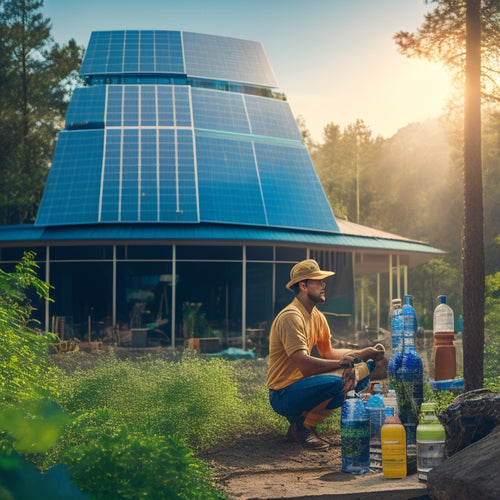Top EV Parking Lot Solar Installation Methods
Share
When designing EV parking lot solar installations, you'll need to select the appropriate method to guarantee maximum energy production and safety. Solar canopy installations take into account site conditions, structural requirements, and electrical infrastructure. Rooftop solar panel mounting requires analyzing the existing roof's structure and material. Ground-mounted solar arrays offer flexibility in system size and design. Solar carport structures necessitate sturdy foundations and sufficient support for panels. Bifacial solar panels can increase energy output by harnessing light from both sides. By understanding these methods, you'll be able to tailor your installation to meet the unique demands of your EV parking lot, and further exploration will reveal even more insights.
Key Takeaways
• Consider structural integrity and load-bearing capacity of the parking lot's roof or canopy to support solar panels and EV charging infrastructure.
• Opt for bifacial solar panels to maximize energy output and reduce land use, especially in areas with high reflectivity.
• Ensure solar carport structures are engineered to provide sufficient support for solar panels and can withstand environmental factors like wind and snow.
• Conduct thorough soil analysis for ground-mounted solar arrays to ensure the soil's bearing capacity, settlement, and erosion potential can support the system.
• Analyze the existing parking lot's condition, material, and slope to determine the most suitable solar panel mounting method, whether ballasted or clamped frames.
Solar Canopy Installation Methods
When designing a solar canopy installation, you'll need to take into account the specific site conditions and structural requirements that will impact the type of installation method you choose.
This includes ensuring Solar Permitting compliance, which involves obtaining necessary permits and approvals from local authorities.
You'll also need to assess the Structural Integrity of the canopy's foundation and support system to guarantee the installation can withstand environmental factors like wind and snow loads.
Additionally, consider the weight and size of the solar panels, as well as the electrical infrastructure required to connect the system to the grid.
Rooftop Solar Panel Mounting
Designing a rooftop solar panel mounting system demands thorough consideration of the existing roof's structure, material, and condition to guarantee a secure and durable installation. You'll need to assess the roof's load-bearing capacity, slope, and material to determine the best mounting approach.
Ballasted systems, which use weights to secure the panels, are suitable for flat roofs, while clamped frames are ideal for pitched roofs. Clamped frames attach directly to the roof's structure, providing a sturdy anchor for your solar panels.
When selecting a mounting system, consider factors like wind resistance, snow loads, and thermal expansion to make certain your rooftop solar panel installation meets local building codes and withstands environmental stresses. By choosing the right mounting system, you'll establish a safe and efficient EV parking lot solar installation.
Ground-Mounted Solar Arrays
You'll opt for ground-mounted solar arrays when your EV parking lot's terrain or existing infrastructure precludes rooftop installations or you need to accommodate larger solar panel systems. This approach allows for more flexibility regarding system size and design.
When designing your ground-mounted system, consider tilt optimization to maximize energy production. Conducting a thorough soil analysis is also important to guarantee the structural integrity of your installation. This involves evaluating the soil's bearing capacity, settlement, and potential for erosion.
Solar Carport Structures Design
Solar carport structures can be engineered to serve as both a parking shelter and a solar energy harvesting system, allowing you to generate clean energy while protecting your electric vehicles from the elements.
When designing these structures, it's crucial to take into account column spacing, which affects the overall structural integrity. You'll want to make sure that the columns are spaced far enough apart to accommodate vehicle parking, while also providing sufficient support for the solar panels.
A well-designed carport structure will provide a sturdy foundation for your solar array, ensuring maximum energy production and minimizing maintenance costs.
Bifacial Solar Panel Installation
When integrating your EV parking lot solar installation, consider bifacial solar panels, which can increase energy output by up to 25% by harnessing light from both the front and back sides of the panels.
These panels offer several bifacial benefits, including enhanced energy production and reduced land use.
To maximize energy output, it's essential to optimize panel orientation. You'll want to tilt your bifacial panels at an angle that allows them to capture both direct and indirect sunlight.
Additionally, consider the surrounding environment, taking into account any shading or reflectivity that may impact energy production.
Frequently Asked Questions
Can Existing Parking Lot Lighting Be Integrated With Solar Installations?
You can integrate existing parking lot lighting with solar installations by performing a lighting retrofit, which allows you to harness energy from the sun, increasing energy harvest and reducing your reliance on traditional energy sources.
How Do Solar Panels Affect Parking Lot Snow Removal and Maintenance?
"A million snowflakes can't prepare you for the challenges of snow removal and maintenance with solar panels! You'll need to adjust winter operations, ensuring snow plows avoid damaging panels, and consider de-icing methods that won't compromise safety concerns."
Are There Any Tax Incentives for EV Parking Lot Solar Installations?
You can claim Federal Credits of up to 26% of the total cost and State Rebates, which vary, to offset the investment in your EV parking lot solar installation, maximizing your return on investment.
Can Solar Panels Be Installed at an Angle for Better Energy Production?
Imagine you're a master photographer, adjusting your camera for the perfect shot. Similarly, optimizing solar panel angles can boost energy yield. Yes, solar panels can be installed at an angle for better energy production, using angle optimization techniques to maximize energy yield.
Do Solar Panels Increase the Parking Lot's Liability Insurance Premium?
You'll likely see minimal impact on insurance rates, as solar panels are considered a fixed installation; however, you may need to notify your insurer and adjust your policy to reflect the added value, avoiding potential policy changes.
Related Posts
-

What Tax Deductions Apply to Sustainable Building Materials?
You can claim various tax deductions for sustainable building materials, thanks to over 40 federal tax incentives sup...
-

Why Vertical Gardens Reduce Home Energy Consumption
By incorporating a vertical garden into your home design, you'll reduce energy consumption through natural insulation...
-

Green Deck Options: Earth-Conscious Choices for Your Home
You're looking for a deck that not only enhances your home's exterior but also aligns with your eco-friendly values. ...


